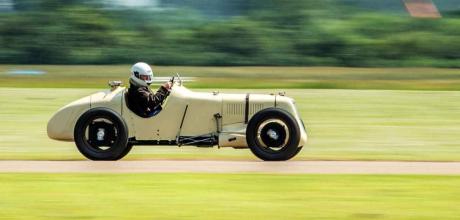1935-spec MG Midget R-type replica
This MG R-type replica is closer to the original than any of the ten built by MG in 1935. John Simister investigates. Photography Aston Parrott.
Even better than the real thing
MG R-TYPE
Driving the most original example never made
The British art of self-deprecation, as practised by old-MG expert and creator of miracles from thin air, Geoff Enoch: ‘It was a stupid project. I’m not quite sure why I did it.’ But clues soon emerge.
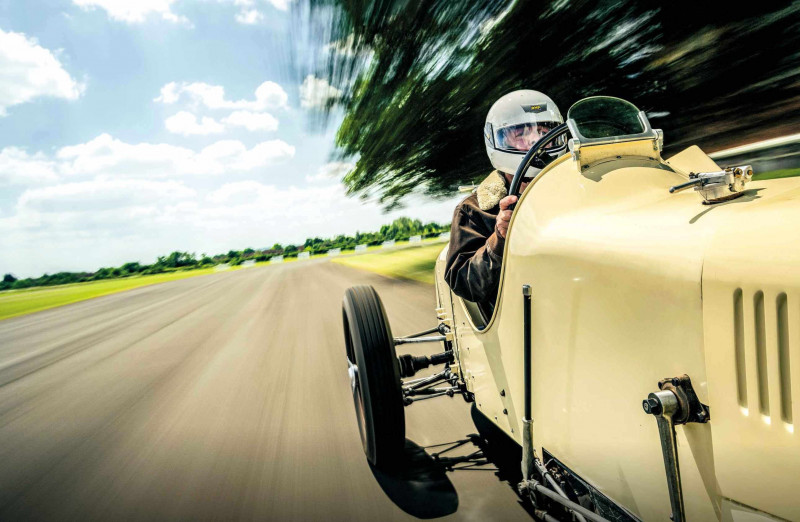
'I turn, the seat's backrest flexes worryingly and I have to lean hard into the corner to make sure I don't fall out'
Enoch is an experienced MG restorer, having for many years owned a company called Octagon Services. And, out of a mixture of curiosity and a desire to learn new skills, about 15 years ago he bought himself an arc welder (as used by MG in the 1930s) and made a tool to create large swaged holes. To practise these skills, he set about making a chassis to the pattern of an intriguing cul-de-sac in pre-war racing MG development: the MG R-type.
Ten of those were built originally, in 1935. Four are complete and running, the rest are either under some sort of restoration or have disappeared. None is known still to be in original specification. All represent a Damascene moment in car design, for Britain at least: the R-type has independent suspension, effectively by double equal-length wishbones, on all four wheels, and a backbone chassis of hitherto never-attempted (by MG) rigidity.
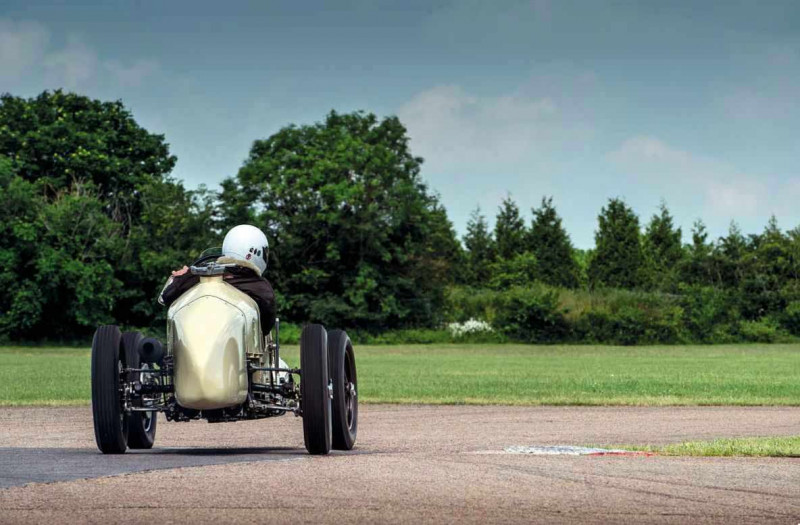
Enoch thought that backbone chassis, in the shape of a giant tuning fork, would make an interesting reproduction project. ‘And having made the chassis, I thought: why not make the rest of the car?’ So he did. And it helped that a friend teased him about the beautiful but initially purposeless chassis, drawing for him a cartoon showing it as a garden sculpture.
Armed with the many original R-type engineering drawings that still exist, plus much photographing and measuring of existing cars, Enoch felt he could create a brand new R-type. Some components common to other post-vintage MGs could be bought, but mostly the pieces would have to be cast, machined or fabricated from scratch. Do-it-yourself seldom has a meaning deeper than this.
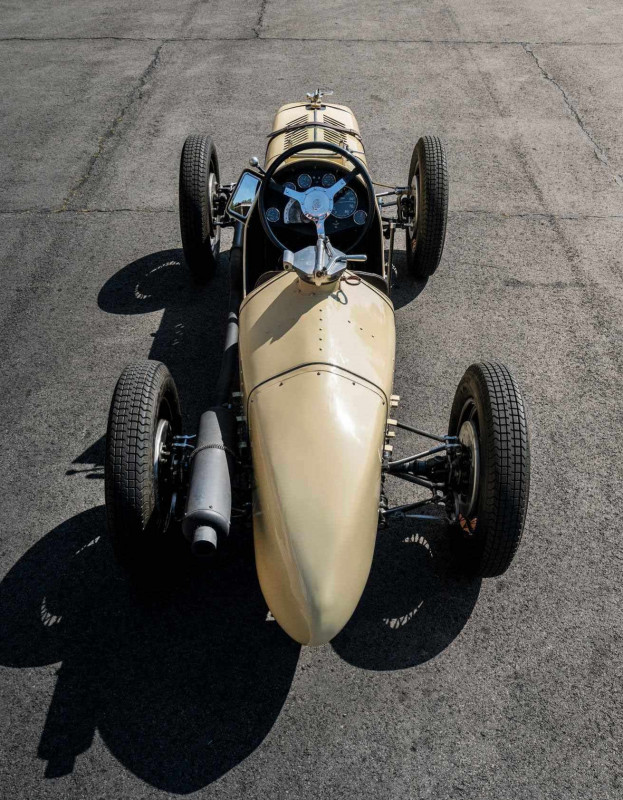
Now, a decade and a half after his electric welder’s first sparks, Enoch is proudly showing me the most original R-type in existence. How so? Because no other extant example so accurately portrays the R-type as originally built. Maybe the car (whose chassis Enoch has numbered BA.0261, the original machines having run from BA.0251 to BA.0260) doesn’t have actual combinations of molecules brought together 86 years ago, but it technically matches those combinations better than its ten predecessors now do.
The Vintage Sports-Car Club, one of Britain’s ultimate arbiters of old-car authenticity, has even issued an eligibility document, the first time it has done so for a ‘new build’. In it, the declaration that the R-type is ‘standard’ has written next to it ‘Must not be developed’.
Enoch’s MG is to remain the benchmark for all that came before it.
Embarking on such an ambitious project would be an impossible dream for most of us, but Enoch has form, manifested by his supercharged MG J2, which he based on an incomplete section of aJ2 chassis discovered in a field in its later role as a home-made trailer. But suitable parts for that weren’t so hard to find. Making an R-type front suspension upright, for example, was a whole lot harder.
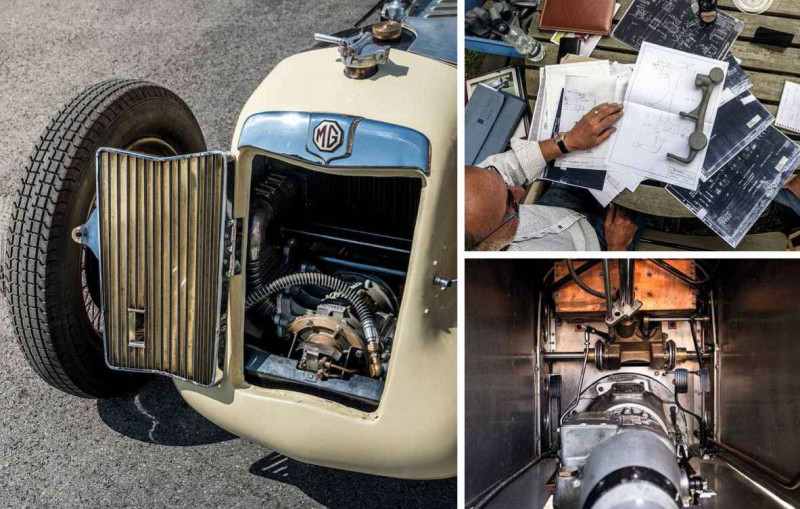
How hard? ‘I machined it from solid. It took a year, but it was only a little mill. It was like being a sculptor making a horse out of marble, chipping away the bits that don’t look like a horse. Or an upright.’
Quite laborious, then, ‘There are 28 components per suspension corner, and right- hand and left-hand threads to turn on their bronze bushes. It was a nightmare, Then there were the brake drums. Did you know that iron moves when it’s cast? It took three attempts to get the dimensions right. And when I did, I had to make five drums because I cocked one up.’
Enoch has brought with him some of the engineering drawings, including ones he drew himself after measuring existing R-types. And he has brought patterns — some wooden, some of resin — that he made for the sand castings. ‘I think everything bar some suspension parts has been made as it was in 1935, but my friend Julian said he’d get a five-axis mill so we could make the rear hubs and the kingpin swivels.
My car was a good way to learn how to use it.’ Julian Stokes runs a company called Precision Sheet Engineering.
Then there was the Zoller supercharger, built up after ‘I located some castings in Australia’ by Tom Dark, who also masterminded the rest of the 746cc overhead-camshaft engine with its Cosworth pistons and Phoenix crankshaft. And the steering box: ‘I was fortunate, here’s a car in Germany, and the owner, Gerhard Maier, had two steering boxes made. He let me have one of them.’ Then the brass top of the front grille, for which Enoch made a forming tool that he accepts will never be used again.
The vertical slats below, forming a door that opens to allow access to the front of the engine, are original, though, They come from BA.0251, which now belongs to Mark Piercy, who has restored it (with new slats). ‘I was measuring and photographing bits of his car and he said “Would you like the chrome bits?” I couldn’t have built this car without him.’ Piercy even lent Enoch 0251s differential casing, so he could take a papier-mache mould.
Enoch’s friend Dave Wood, a metalworking wizard, made the scuttle section on an English wheel, and did the same for the tail section with Enoch’s help because one person couldn’t reach far enough. He was paid with a BSA 650. ‘Dave is just brilliant,’ says Enoch.
Enoch made the steering wheel, drew the driveshafts for GKN to make, fabricated the steel brake shoes (‘I cheated by having the pieces laser-cut’), and created the complex wishbone pivots with bushes threaded on the inside and outside, They are heated up, tinned then threaded into their carriers, after which the threaded shafts (machined from EN24 steel, Enoch tells me) are screwed into them, The uprights are made from EN27. This stuff matters.
WHAT, THEN, IS an R-type? It was designed by MG founder Cecil Kimbers forward- thinking engineer Hubert N Charles, not only to go racing but also to test the independent suspension system that Charles envisaged for a new MG luxury saloon. He realised that leaf springs, solid axles and a flexible chassis were less than ideal for optimum grip and traction, especially on bumpy surfaces such as the Brooklands banking. So he devised a stiff chassis from which the wheels, attached to it by equal-length double wishbones, were independently sprung by torsion bars.
The steering box, mounted on the scuttle, transferred its motion to the front wheels by a long fore-and-aft drag link on each side, to make sure the movement of neither front wheel affected the other. It was a remarkable mechanism, containing two contra-rotating worm-drives geared together, The gearbox was MG’s favoured Wilson pre-selector unit and, despite modernity elsewhere in the running gear, the drum brakes were cable-operated, The tiny engine gave around 113bhp on methanol.
For their race debut, six R-types were entered for the JCC International Trophy at Brooklands on 6 May 1935. Cars BA.0251, 0252 and 0253 formed a semi-works team and were driven by Norman Black, Wal Handley and George Eyston. Doreen Evans in 0255 was entered by Bellevue Garage, the family firm. W Esplen and Gunnar Poppe were in 0256, WG Everitt and Malcolm Campbell in 0260. Contemporary reports told of alarming roll on the corners, and only two R-types finished — 0260 in sixth overall and Doreen Evans’ 0255 seventh, but first and second in their class.
‘Enoch, felt he could create a brand new R-type: do-it-yourself seldom has a meaning deeper than this’
Clearly there was development work to do, but not by the factory. Up to 1 July 1935, MG had been an independent company, albeit owned by William Morris and using many Morris components. On that day he sold MG to Morris Motors, of which Leonard Lord — later chairman of Austin and then BMC — had recently become managing director. Lord disliked Kimber, any notion of independent design thought and any profligate racing activity, so he closed the racing department and relocated design to Morris’s Cowley domain.
The new luxury saloon was cancelled and the R-typeswere sold off. Private owners continued to race them with not much success, although Doreen Evans set a new ladies’ record at Shelsley Walsh hillclimb. Three cars gained experimental twin-cam heads for 1936, but their potential went unrealised. Nevertheless, R-types still sometimes come out to play for Historic events, a tantalising glimpse of what might have been.
Enoch revealed his completed R-type at Brooklands in April 2015, triggering discussion as to whether it counted as a real R-type. Quite the metaphysical conundrum, but it seems pretty real to me. And now he’s about to take it for a run around the Bicester Heritage test track, the first proper drive he has had in it. Since Brooklands he’s been fettling it and fiddling with it, but he has never had the chance to experience the fruits of his efforts.
Dave Wood is helping to get it ready. It starts instantly, then stops. Did the friction in the first-gear band stop it? Possibly. Is the carburettor flooding? Yes. Enoch has been retuning the engine to run on petrol, on which it will make a still-ample 90bhp or so, and a little more carb tweaking is required.
This done, the MG fires up, stays firing, and an apprehensive Enoch selects first. ‘It’s such a funny thing to be doing this after 10 or 11 years’ work,’ he muses. He eases up the clutch and tentatively moves off. ‘Magnificent,’ he chuckles to himself as he takes to the track, R-type sounding crisp and sweet.
Two or three laps later, having driven the R-type further than ever before, Enoch returns. ‘It’s unbelievable,’ he enthuses, ‘like driving nothing else.’ And all his own work, he thinks but doesn’t say.
Now he wants me to have a go, to tell him what I think. His trust is touching, and I really don’t want to be the one to undo all that work. So I clamber carefully over the side, lower myself into the seat as I thread my legs past the giant steering wheel and lightly burn my left hand on the exposed exhaust a fraction of a second before Wood warns me not to.
Now to try the clutch action, the starting point for getting to know a driving position. It’s hard even to find the pedal and place my size seven on it in the congested footwell. A discreet foot-clearing bulge in the bodywork might help here, I suggest. Switch on, fire up, clutch down, move the little switch-like gearlever to position one in its quadrant just beyond the steering wheel, clutch up and we’re off.
First gear proves long-legged, in typical racer fashion, as the engine spins crisply and eagerly to what revs I don’t know, because the tachometer doesn’t work. Nor does the speedo. It’s a smooth unit, too, and has a muscularity hard to reconcile with 746cc. Second is preselected with the lever, then engaged by pressing and releasing the clutch. Ditto third, and here come the first Bicester bends.
The brakes feel firm enough and respond reassuringly. I turn, the seat’s backrest flexes worryingly and I have to lean hard into the corner to make sure I don’t fall out over the low cockpit sides, The R-type does indeed take on alarming roll angles. As well as its unsettling effect on the driver, this also causes the wheels to lean a similarly large amount away from their optimum verticality thanks to the equal-length wishbones, There was still a lot to learn about all-independent suspension in 1935.
Why does it roll so much? The centre of gravity is high, the springs soft, There are no anti-roll bars, though these were a rather later innovation. And it feels the polar opposite of ‘planted’, The nose pushes hard in understeer as the MG turns in, and the steering gets heavy, but lightens as I power out of the bend — whereupon the tail feels loose and threatens to snap quickly into oversteer. A neutral phase, loading all wheels equally, is notably absent. Were the track wet, I think it would spin.
It’s the first time this R-type has been exercised with vigour, and we’re at the bottom of a learning curve with unknown axes, The lever-arm dampers were reckoned not to be up to the job in 1935, and both they and the springing could probably do with firming-up to tighten the transient responses and keep the wheel cambers under better control. Enoch plans to get an expert preparer of Historic racing cars to set it up better, but today’s experiences have given a useful starting point.
For all that, though, the MG feels quite supple on Bicester’s bumpy track, and more all-of-a-piece than a typical beam-axled contemporary would have done. I don’t get as far as fourth gear because it proves unobtainable, preselector position four delivering neutral instead, but we’ve discovered enough to know that Hubert Charles had taken the first tentative steps along the right road.
And then, as I blare along Bicester’s main straight in third gear, engine sounding very happy and all working dials showing the right readings, something in the powertrain suddenly tightens. I declutch immediately and feel a bit sick. Have I unwittingly broken it?
Back in the paddock area, we discover that the crankshaft still turns but the supercharger does not. It might have seized, but Enoch is upbeat about the ease of repair. He’ll tell me later that a ring nut on a supercharger bearing self-tightened as the unit heated up, jamming the shaft, and all was easily fixed. Eighty-six years after the first R-types were built, and six years after the last one, I’m glad I didn’t ruin the most original-spec R-type of all.
Above, below and right Seeing the structure beneath the bodywork makes clear how complex a job this was; tiny engine is supercharged — and punches above its weight; sense of scale in this view shows how Midget lives up to its name.
Clockwise, from above Engine is accessed via hinged louvres — from an original R-type; period drawings were key to the construction of this replica; driver must straddle the prop-shaft; full complement of period clocks; at speed in the R-type’s natural environment.
Opposite and above It began with the purchase of an arc welder, progressed with the fabrication of a chassis, and ended with the reproduction of an entire car — here seen being test-driven at Bicester Heritage.
TECHNICAL DATA 1935-spec MG Midget R-type
- Engine 746cc OHC four-cylinder, SU HV8 carburettor, Zoller supercharger
- Max Power 113bhp @ 6500rpm (on methanol in period). Approx 90bhp on petrol today
- Max Torque 78lb ft @ 3900rpm
- Transmission Four-speed Wilson pre-selector, rear-wheel drive
- Steering Cam Gears worm-and-peg
- Suspension Front and rear: double wishbones, torsion bars, Luvax hydraulic lever-arm dampers
- Brakes Drums, cable-actuated
- Weight 630kg
- Top speed 110mph (est)
- 0-62mph 11.3sec


